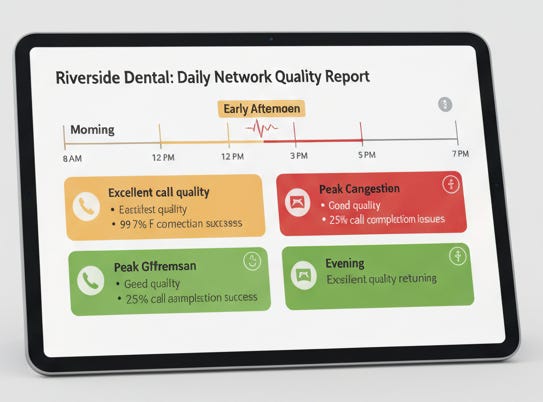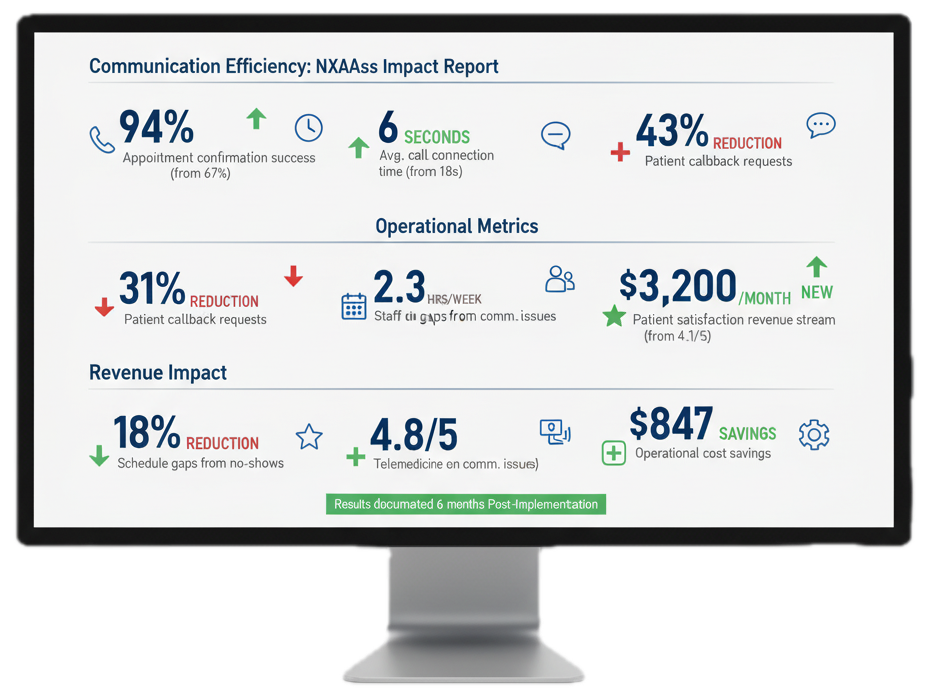NXaaS In Action: SMB Turns Network Signals Into Customer Insights
Part 4 of our NXaaS series exploring real-world implementations
Kiran Patel thought he was making a smart business decision when he switched his dental practice to VoIP phones. The cost savings were immediate, no more expensive landline bills, and the features were impressive: call forwarding, voicemail-to-email, and integration with his patient management system.
But three weeks after the switch, his office manager pulled him aside with concerning news. Patients were complaining about call quality during appointment confirmations. Some calls were dropping entirely. Others sounded garbled or had annoying delays that made conversations awkward.
“It’s always in the afternoon,” she explained. “Around 3 o’clock, everything goes to hell.”
For a small dental practice like Riverside Dental, every phone call matters. Missed appointment confirmations lead to no-shows. Poor call quality during insurance verification creates delays. When patients can’t reach the office to reschedule, it creates gaps in the schedule that directly impact revenue.
Kiran found himself in the frustrating position of many small business owners: he knew there was a problem, but had no idea how to diagnose or fix it.
His internet service provider blamed the VoIP vendor. The VoIP vendor blamed network congestion. Nobody offered solutions.
The Small Business Dilemma
Small businesses face unique challenges with network infrastructure. Unlike enterprises with dedicated IT staff, SMBs typically rely on “it works or it doesn’t” approaches to technology. When problems arise, business owners find themselves troubleshooting systems they never intended to become experts in.
Kiran’s situation was particularly common in healthcare settings. Medical practices increasingly depend on digital communications, e.g. VoIP phones, patient portals, telemedicine platforms, and cloud-based practice management systems. When network performance degrades, it doesn’t just affect productivity; it impacts patient care and business operations.
The challenge for SMBs is visibility. Enterprise networks have monitoring tools, dedicated staff, and service level agreements. Small businesses often discover network problems only after they’ve already affected customers.
Dashboard Intelligence for Main Street
Kiran deployed NXaaS with a business-focused dashboard designed specifically for non-technical users. Instead of network graphs and technical metrics, the system presents information in terms that small business owners understand: customer impact, operational efficiency, and revenue implications.
His NXaaS dashboard immediately revealed the pattern his office had noticed:
Daily Network Quality Report:
Morning (8 AM - 12 PM): Excellent call quality, 99.7% connection success
Early Afternoon (12 PM - 3 PM): Good quality, minor latency increases
Peak Congestion (3 PM - 5 PM): Poor quality, 23% call completion issues
Evening (5 PM - 7 PM): Excellent quality returning
The system identified the problem and, importantly, explained the cause. Mobile network congestion in Kiran’s area spiked dramatically between 3-5 PM due to nearby school dismissals. Hundreds of teenagers were simultaneously streaming videos, downloading apps, and video calling friends, saturating the local cellular towers that his internet provider relied on for backup connectivity.
Predictive Business Intelligence
What transformed NXaaS from a monitoring tool into a business intelligence platform was its predictive capabilities. The system began providing a “Call Quality Forecast” that worked like a weather report for network conditions:
Today’s Forecast:
Morning: Clear conditions, optimal for outbound calls
Afternoon: Network storm expected 3:15-4:45 PM, avoid non-essential calls
Evening: Conditions improving, good for appointment confirmations
Tomorrow’s Outlook:
High congestion expected: School board meeting at nearby high school (4-6 PM)
Recommendation: Schedule patient follow-up calls before 2 PM or after 6 PM
Weekly Pattern Analysis:
Best call quality: Tuesday and Wednesday mornings
Avoid if possible: Friday afternoons (highest congestion)
Opportunity: Sunday evenings show excellent quality for international calls to specialist referrals
Operational Intelligence That Drives Results
The insights went beyond call quality to broader business intelligence. By analyzing SIM presence data, signal strength patterns, and usage metadata, NXaaS helped Kiran optimize his entire practice:
Patient Communication Optimization: The system identified that appointment reminder calls made before 2 PM had 94% connection success rates, while calls after 3 PM dropped to 67%. Kiran’s staff now batch outbound calls in the morning, dramatically improving patient contact rates.
Staff Scheduling Intelligence: Network data revealed that telemedicine consultations worked best during off-peak hours. Kiran began offering evening virtual consultations at premium rates, turning network insights into new revenue streams.
Emergency Preparedness: When severe weather affected cellular towers, NXaaS automatically rerouted critical calls through alternative pathways and sent alerts about expected service degradation, allowing staff to adjust patient communications proactively.
The Technical Foundation
Behind Kiran’s business-friendly dashboard, NXaaS orchestrates multiple data sources to create actionable intelligence:
SIM Presence APIs monitor cellular connectivity quality and detect when devices switch between towers or network types. This reveals patterns in local network congestion and helps predict quality degradation.
Signal Strength Analysis tracks not just current conditions, but trending patterns that indicate developing problems before they affect call quality.
Usage Metadata analyzes call patterns, connection success rates, and quality metrics to identify operational opportunities and customer experience improvements.
Location Intelligence correlates network performance with geographic and temporal factors—school schedules, local events, weather patterns, and community activities that affect network usage.
Predictive Analytics combine historical patterns with real-time conditions to forecast network quality hours or days in advance.
Measurable Business Impact
Six months after implementing NXaaS, Riverside Dental documented significant improvements:
Communication Efficiency:
Appointment confirmation success: Improved from 67% to 94%
Average call connection time: Reduced from 18 seconds to 6 seconds
Patient callback requests: Reduced by 43% due to clearer initial calls
Operational Metrics:
Schedule gaps from no-shows: Reduced by 31% due to better appointment confirmations
Staff time on communication issues: Reduced by 2.3 hours per week
Patient satisfaction scores: Increased from 4.1/5 to 4.8/5
Revenue Impact:
Monthly appointment volume: Increased 18% due to better scheduling efficiency
Telemedicine revenue: New $3,200/month revenue stream from optimized evening consultations
Operational cost savings: $847/month from optimized communication timing
Small Business Lessons
Kiran’s experience highlights important principles for SMB technology adoption:
Business context trumps technical detail. Small business owners need to understand how technology problems affect customers and revenue, not network protocols and bandwidth measurements.
Predictive insights enable proactive management. Instead of reacting to problems after they affect customers, businesses can anticipate and prevent issues.
Operational intelligence creates competitive advantage. Understanding when and how to communicate with customers based on network conditions becomes a business differentiator.
Simple interfaces hide complex technology. The most powerful business intelligence systems are often the easiest to use, translating technical complexity into actionable business decisions.
ROI comes from optimization, not just problem-solving. The greatest value came not from fixing VoIP issues, but from using network insights to optimize scheduling, create new services, and improve customer experience.
Beyond the Dental Chair
The success at Riverside Dental has implications for thousands of similar SMBs. Any business that depends on digital communication, e.g. restaurants with delivery apps, retail stores with mobile payment systems, service providers with field technicians, etc. can benefit from network intelligence that translates to business intelligence.
The key is making sophisticated network analytics accessible to business owners who need results, not technical explanations. When network data becomes business intelligence, small companies can compete with larger enterprises that have dedicated IT resources.
The Future of SMB Intelligence
Kiran’s dashboard continues to evolve. NXaaS is now exploring integration with his practice management system to automatically adjust appointment types based on expected network conditions. High-bandwidth telemedicine sessions get scheduled during optimal periods, while routine phone consultations can handle lower-quality windows.
The system is also beginning to correlate network patterns with patient behavior, identifying opportunities for proactive outreach when communication conditions are ideal.
This represents a fundamental shift in how small businesses can leverage technology: from reactive problem-solving to predictive optimization that drives growth and customer satisfaction.
NXaaS (Network-as-a-Service) transforms complex network infrastructure into conversational interfaces that anyone can understand. Learn more about implementing NXaaS in your organization at buglabs.net.




